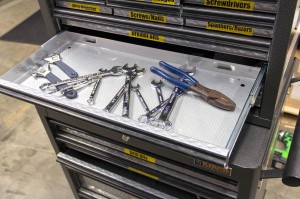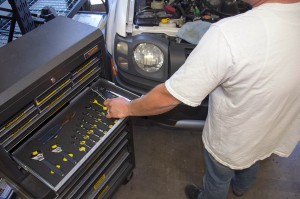I’m admittedly a bit of a 5S curmudgeon. I blame it mostly on the fact that I have routinely witnessed well-applied 1S, 2S, and 3S, evaporate in the absence of any meaningful 4S. It’s like so much in lean, when we fail to understand that any technical change requires a management change, bad things happen.
In other words, the first 3S’s matter little if we don’t do some of the things that 4S requires – assigning 3S responsibilities, integrating 3S duties in regular work duties, and checking on 3S maintenance levels (not to mention preventing things from getting dirty in the first place). Here, our guest-blogger, Tony Ferraro, talks about another critical part of the fourth S – standardizing the lines, labels, shadows, presentation, etc. that was developed beforehand.
___________________________________________
5S is one of the most effective tools within the realm of workplace organization. Since its inception, 5S  has gained a loyal following in many different types of work environments. Companies that have truly embraced 5S enjoy high levels of organization and efficiency.
has gained a loyal following in many different types of work environments. Companies that have truly embraced 5S enjoy high levels of organization and efficiency.
For those of you unfamiliar with 5S, it is an acronym used to describe five different, yet integrated practices that all begin with the letter S. They are as follows: sort, set in order, shine, standardize, and sustain. It seems that most businesses engaged in the practice of 5S do a rather nice job implementing at least the first three S’s. However, the fourth S, standardize, consistently seems to lag in the background.
Why is this?
Is it that standardize is hard to implement? Misunderstood? Undervalued?
An Example - Standardize in an Auto Shop
Here’s a quick story about standardization, also known as standardized cleanup. The setting for this story is an auto shop.
Now, auto shops have a well-earned reputation for disorganization and uncleanliness. Originally, this one was no different.
The primary purpose of standardization is to ensure that work stations and equipment are set up in a similar manner, kept clean, and maintained in line with 3S responsibilities - including regular work duties and maintenance. For more information, please refer to Hirano’s book entitled “5 Pillars of the Visual Workplace.” One important goal is for associates to be able to walk up to any work station and locate any needed tool or item quickly and easily since all stations are consistently organized.
Our auto shop had made some great progress and had a good handle on the first three of the 5S’s but struggled with the fourth S. However, due to the individualized organization of tools and equipment, employees were unable to use different work stations to and perform the same high level of work efficiency.
In a nutshell, everyone had their station set-up differently according to their specific likes and dislikes. When other employees needed to use a different station, they would spend unnecessary time reorganizing the space and equipment to meet their needs. Some common problems included misplaced tools, disorganized workspaces, and overall losses in production time. The sad truth was that a lack of standardization was eroding the success achieved with the first three S’s.
Consistent with the notion of 5S, we employed a visual approach towards standardization. We gathered the employees and set-up the ideal, universal workstation by taking each employee’s opinions and thoughts into consideration. A photo of the pilot workstation was then posted at all of the other workstations.
Employees took ownership of the workstations by setting them up in the specific and uniform manner according to the agreed set-up and photo illustration. Foam tool organizers were extremely useful in the effort. The organizer helped to keep all tools presented similarly at each work station and then also made each employee accountable at the end of his or her shift to have all tools back in their predetermined locations. Just like the saying goes, every place has its tools and every tool has its place.
Don’t Overlook the Benefits of Standardization
Even though standardization may seem trivial, don’t underestimate how it can help create and help maintain an effective and efficient work space. Standardizing workspaces can help engage employees and create a universally organized and well understood workplace for all stakeholders. Please familiarize yourself with the fourth S and re-energize your 5S culture.
Antonio Ferr aro, on behalf of Creative Safety Supply based in Portland, OR (www.creativesafetysupply.com), authored this guest post. Tony strives to provide helpful information to create safer and more efficient industrial work environments through 5S, six sigma, kaizen, and applying a lean mindset.
aro, on behalf of Creative Safety Supply based in Portland, OR (www.creativesafetysupply.com), authored this guest post. Tony strives to provide helpful information to create safer and more efficient industrial work environments through 5S, six sigma, kaizen, and applying a lean mindset.
Related posts: Ineffective Visual Controls – 9 Root Causes, Scrunchie Lean, Visual Controls, Spider-Man, and Do Hotel Chains Really Care About Saving the Planet?

